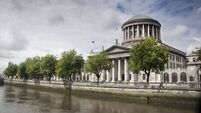Cork Luas: What 1,000 residents have to say about light rail plan
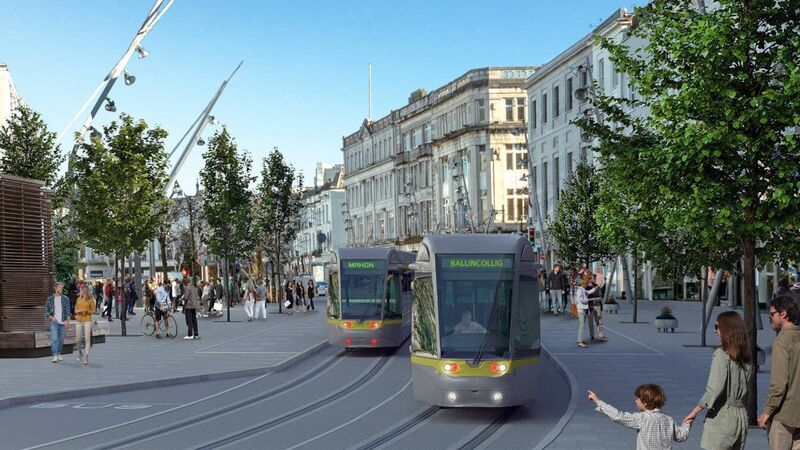
St Patrick's Street is at the centre of the proposed Cork Luas route, but many of the public observations focus on either end, including Ballincollig and Ballintemple — and the 'missed opportunity' that it does not connect to Cork Airport and areas including Blackpool and Glanmire.
There were times when Brendan Crowley could leave Dublin Airport at 6.30am on a flight to Manchester and be at work in an office in Cheshire at 8.45am.
The Cork man used planes, trains, and automobiles to get from his then home in Kildare to a work engagement in Crewe, some 48km from Manchester Airport.
“I would have to get up at 4.30am because I was living in Kildare. The longest part of my journey was going from Kildare to Dublin because that was in a car,” he explained.
Now living in East Cork, he is keenly aware, because of his experiences both in England and cities around Europe, of the importance of rail and light rail.
As a result, Brendan entered one of the 1,003 submissions received in the consultation process launched in the early summer on the emerging preferred route for Cork’s light rail system, Luas Cork.

The proposal is for an 18km light rail line linking Ballincollig and Mahon, through the city centre. Among the locations to be serviced by the line will be the Munster Technological University, Cork University Hospital, University College Cork, Kent Station, the Docklands, Páirc Uí Chaoimh, and Mahon.
It is projected that the journey time from Ballincollig to the city centre will be 35 minutes. The total journey time from Ballincollig to Mahon, taking in the city centre, will be 55 minutes.
As part of the project, a 1,000-space park-and-ride facility is to be located in Ballincollig, and a ‘mobility hub’ in Mahon, both equipped with bike parking, EV charging, and pick-up/drop-off points.
Based on transport demand analysis, it is expected that up to 2,300 passengers per hour will use the system in each direction at peak times, according to Transport Infrastructure Ireland (TII).
Services will run every six minutes, or more frequently if demand increases, says the TII.
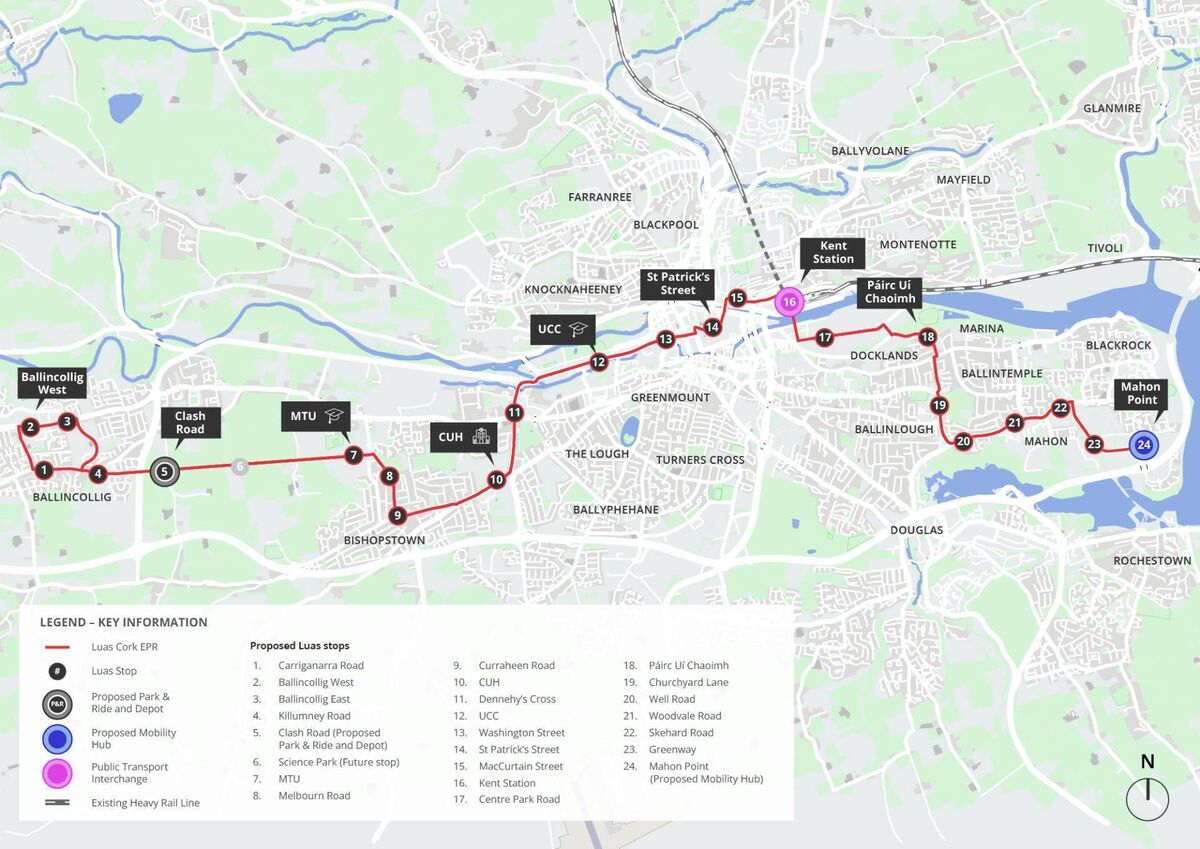
As it stands, the stops on the emerging preferred route will be: Carriganarra Rd, Ballincollig; Ballincollig West; Ballincollig East; Killumney Rd; Clash Rd (which will be a park and ride, and depot); Science Park (future stop); Munster Technological University; Melbourn Rd; Curraheen Rd; Cork University Hospital; Dennehy’s Cross; University College Cork; Washington St; St Patrick’s St; MacCurtain St; Kent Station (public transport interchange); Centre Park Rd; Páirc Uí Chaoimh; Churchyard Lane; Well Rd; Woodvale Rd; Skehard Rd; Greenway, and Mahon Point (mobility hub).
It will also incorporate a new bridge over the River Lee, at Kent Station, linking to Kennedy Quay.
There are no plans as yet to extend the light rail line to Cork Airport, which Brendan believes is a lost opportunity and which he highlighted in his submission.
“I used to spend a lot of time going from my home in Kildare to Dublin Airport to Manchester and down to Crewe," He says.
"Basically, you would get off in Manchester, and there was a railway spur running into the airport. People could either go into Manchester or down to the main rail network for the whole of the UK.”
His submission was among the 181 received which recommend extending Luas Cork to Cork Airport.
In its submission, Cork Airport strongly supported the proposal and encouraged planners to include a future link in the design.
It was also highlighted in the submission from Cork Chamber, which stated:
“It is essential that the current planning for Cork’s light rail system includes consideration of future spurs or extensions, particularly to Cork Airport, as the city’s population, economy, and mobility needs continue to grow.”
The report published last week outlined that:
- 279 respondents (29%) expressed overall support for the project;
- 76 respondents questioned the overall value of the project, and the long-term impact of Luas Cork, with issues including “the limited reach of a single line, particularly its failure to connect important areas in the west and south of Cork, such as the airport”;
- The absence of a second line, running north to south, was also highlighted;
- 52 respondents focused on the current public transport systems, with some respondents arguing that enhancing bus and commuter rail services “could deliver faster and more cost-
effective results than building a new Luas line”. Existing difficulties such as lengthy travel times and limited weekend schedules were raised in the current services in areas including Douglas, Carrigaline, Ballincollig, and near Cork Airport. Some also queried whether the route effectively targets locations with the most urgent need for improved connectivity, and also highlighted that it overlaps with existing public transport services; - 326 submissions (33%) focused on how properties and businesses in their communities would be affected — including 107 each regarding Ballincollig and Ballintemple. The concerns included potential traffic disruption, construction impacts, loss of parking, and safety risks;
- 223 respondents called for the route to include areas such as Douglas, Carrigaline, Rochestown, Frankfield, Ringaskiddy, Ballinhassig, and Ballyphehane;
- 169 respondents proposed extending the route westward to Classis Lake and Ovens, while 181 supported extending Luas Cork to Cork Airport;
- 118 respondents suggested extending the route northward to areas such as Glanmire, Blackpool, Hollyhill, Fairhill, and Mayfield;
- 105 submissions observed that the proposed tram line shares long stretches of road with buses and cars, with many feeling it could “negatively impact the reliability and safety of the service, leading to slower journey times due to traffic congestion and frequent bus stops”.
The creation of a new bridge between Kent Station and Kennedy Quay has raised concerns about a knock-on effect on the maritime life of the city, including the possibility of blocking vessel access to the city centre, and affecting events such as the Ocean to City race.
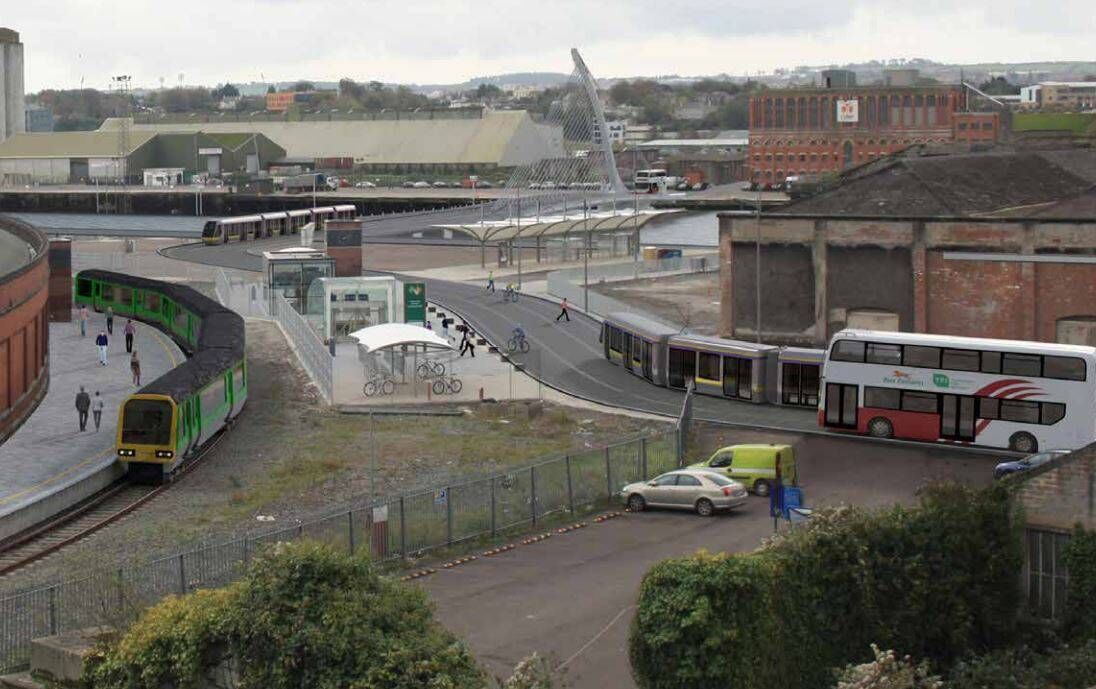
One respondent, Fergus Hurley, said in his submission: “We need a more accelerated delivery programme.
"The line should go along the Cork-Blackrock- Passage-Crosshaven line using the existing bridges from Kent Station to City Hall, so that the old Port of Cork is not sterilised to boats.
“While I appreciate the need for reliability and frequency, the proposed route is too meandering and will take too long.”
The team behind Luas Cork acknowledges the project is not going to be welcomed by everybody.

Paolo Carbone, TII’s head of light rail capital programme, said: “No line can be built without impacting negatively on some residents or some businesses.
“Acquiring a building is something we do as a last resort, and the proof of this is that you can see that the alignment tries to negotiate narrow corners where it is necessary.
“Unfortunately though, there are physical limits to what can be done.
“On balance, we carefully considered the impacts, we weighed up the alternatives, we have assessed the benefits and impacts of these options, and on balance, this is the one that delivers the best possible route.
“Whichever route we choose — and the goal for us is to design a route that serves as many people as possible — based on what we know to be the key destinations, in achieving the least impactful trade-offs possible.”
Among the businesses set to be most impacted by the project will be the Venue Bar in Ballintemple, operated for the past 11 years by Con Dennehy and Kate Tierney.
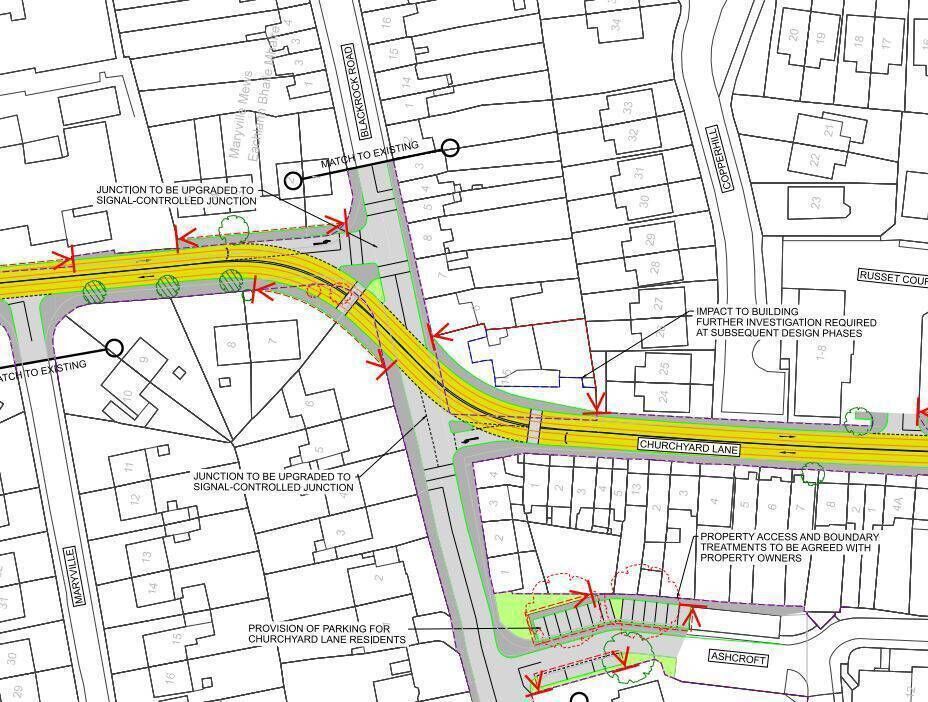
They found out in April, when the emerging preferred route was unveiled, that the Venue was on the route. Maps for the project showed tram lines running through the popular bar.
Mr Dennehy told the that they have been told that they will hear more on what it means for the business in early 2026.
Details of the preferred route will be published in the first quarter of next year with a further public consultation to take place on that.
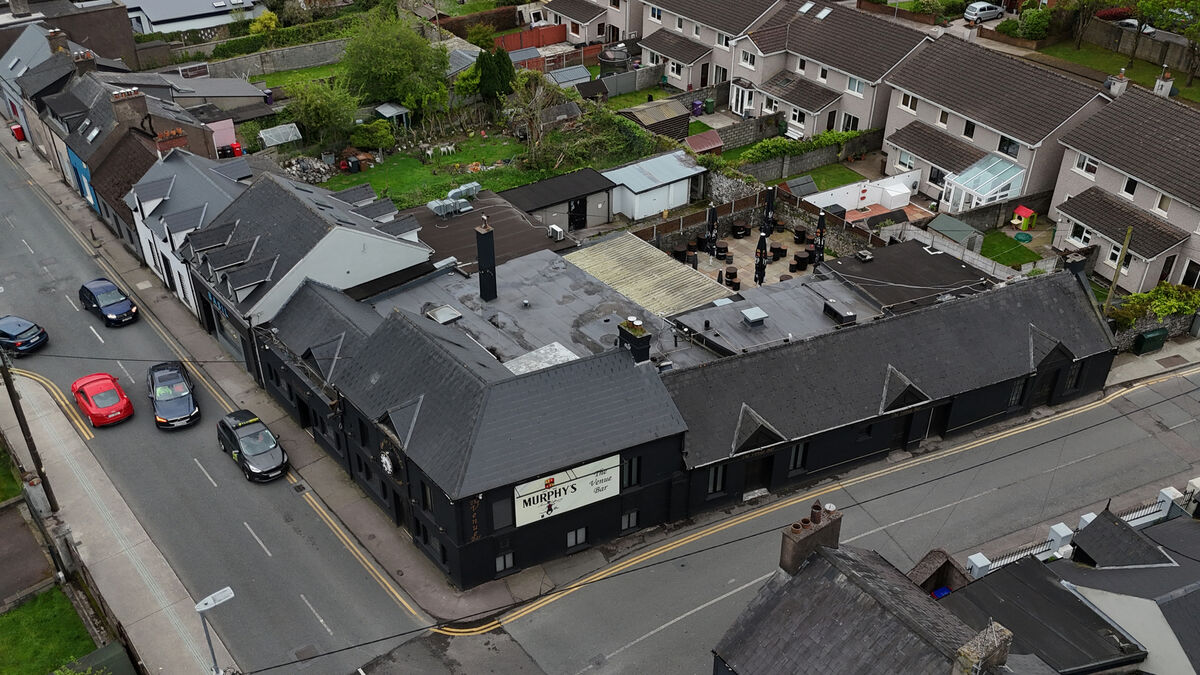
He said the future for the Venue currently remains in limbo, adding: “I wish I knew what was going to happen, but I honestly don’t. It isn’t just us; there are other people in limbo as well that don’t know what’s happening.”
Mr Carbone accepted that the operators of the Venue bar did not hear directly from the project team that it was on the line of the emerging preferred route, but said that they were spoken with the day after the emerging preferred route was revealed in May. He said that further engagement had taken place:
“We intend to go out with the preferred route in quarter 1 of next year. Then there would be a second consultation.
“Following that, we will prepare a railway order, which is a very comprehensive planning permission essentially, that will allow An Coimisiún Pleanála to assess if the development is appropriate. It will allow us to produce a business case that would give us a good indication of the cost.”
If planning is granted, funding will then need to be granted, and Mr Carbone says it is unlikely that the project will be completed before the mid-2030s.
He said that such a timeline is not surprising, given that all of the Luas extensions in Dublin took five years from when approval was granted.
He pledged: “We are going to deliver this project if and when we get the planning and the funding in a way that is sympathetic to all stakeholders, as much as it can be.”
Submissions that raised concerns about the Luas line in Ballincollig centred on two main issues: The proposed loop design, as well as the inclusion of Station Rd on the route.
One submission, from respondent Adam Ryan, said: “The use of single track in Ballincollig is a poor future design choice, as it will both limit capacity for this area in future and it greatly restricts any future extension from the point.
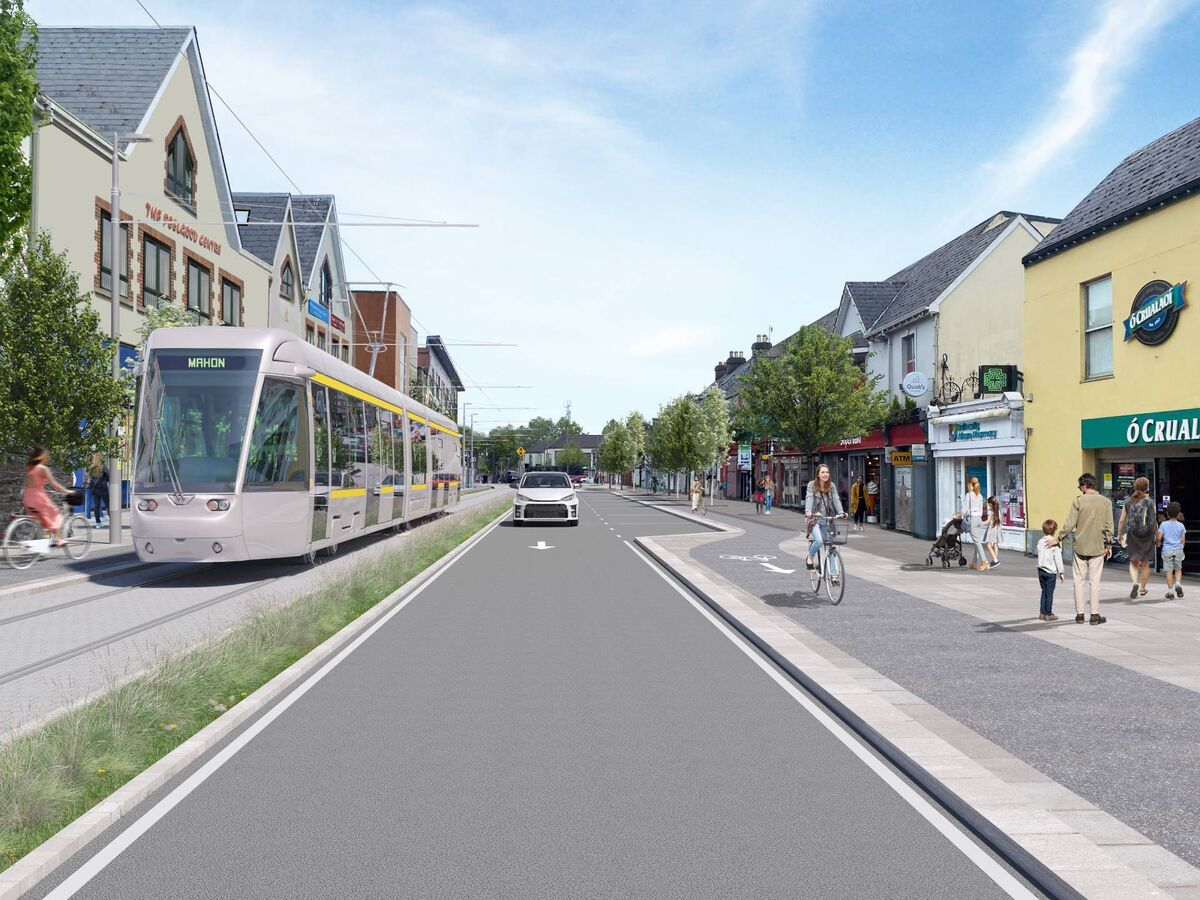
"Double track here would allow a potential future extension further west into Ballincollig and even to Dell EMC.”
Another respondent, Shane Hogan, questioned the rationale for the proximity of stops, stating: “Having four stops in the Ballincollig area, all within relatively the same vicinity, does not make sense.
In relation to the inclusion of Station Rd on the line, residents and local councillors cited the narrowness of the road and congestion, because of its proximity to key community facilities, including primary and secondary schools, a parish church, and a community centre.
Submissions pointed out that traffic was particularly busy during school drop-off and pick-up times.
Questions were also raised about whether the tram would worsen traffic issues, particularly in areas like Muskerry Estate, which already experiences high volumes of through-traffic, said the consultation report.
There was opposition to the proposed one-way traffic system on Station Rd, with concerns that it would restrict access to homes, especially for residents who would be limited to left turns only. Submissions also highlighted the possibility of the creation of “serious challenges for disabled individuals, who require unrestricted driveway access”.
Tony O’Leary said: “Creating a one-way system for traffic on part of the main street is going to add to traffic congestion. There are approximately 170 houses in Carrigdene and Castle Park, all of whom will have to turn left when exiting onto the main street.”
Meanwhile, the owners of Healy’s Bar, on Main St, highlighted the potential loss of two parking spaces and a delivery area to make way for the line.
They said: “We use the private land outside our business as an operational part of the bar... The red-line section you have in the plans will not allow for deliveries to be made to the pub, which has been open since 1932 and operational by our family. We are landlocked on either side and have no other alternative to accept deliveries. It is vital we keep our private land for deliveries.”
Transport and Mobility Forum suggested that the current alignment benefits only a small portion of the population, leaving large residential areas without convenient access to the system.
In its submission, it stated: “The proposed single track ring serving Ballincollig village centre serves only 9% of the developed area of Ballincollig.
We are seriously concerned that having such a small proportion of the population of Ballincollig within walking distance of a station will result in continued car dependency in the majority of the town and hence congestion affecting the service in Ballincollig village and Cork City centre.”
Concerns were raised as to whether the proposed park and ride facility at the east side of Ballincollig could lead to an increase in traffic volumes and congestion in that area of the town.
The proposal to run the preferred Luas Cork line through Ballintemple — including through the Venue Bar — has been met with concern from local residents and local businesses.

Con Dennehy, one of the operators of the Venue Bar, says that local houses and gardens in the Ballintemple and Churchyard Lane are affected by the plan.
“The residents of Churchyard Lane, up behind us, are all being affected and not in a good way, and the same with the people in Maryville,” said Mr Dennehy. “They are being affected adversely as well.
“It is effectively cutting the village in two, between east and west. It’s not a good place to be.”
Submissions made in the public consultation, following the publication of the emerging preferred route earlier this year, included concerns about the potential demolition of buildings, compulsory purchase of land, and possible disruption to long-standing businesses.
These included the potential demolition of the Venue, while businesses located in a building on Skehard Rd, including a barbershop, a beauty salon, a hairdresser, and a pharmacy, were concerned about disruption and potential displacement.
Several submissions were made by residents’ groups, representing areas including Churchyard Lane, Maryville, Russet Court, Avondale, Copperhill, Ardcairn, Temple Hill Lawn, and Beaumont Cottages.
“Comments were made about potential devaluation, loss of privacy, and disruption to daily life,” said the report.
The loss of on-street parking and difficulties accessing relocated parking areas, such as those proposed at Ashcroft Estate, were also raised.
There was concern about the risk to older homes on Churchyard Lane and Maryville, which have “minimal foundations and Victorian-era sewage systems”, according to the report.
The report outlined: “Churchyard Lane is seen as too narrow and steep, already prone to congestion.
“Churchyard Lane is a pinch point on the route. It connects key destinations, but it is narrow, and residents have raised several concerns about the impact on them.”
There was concern about the displacement of traffic to smaller roads, like Crab Lane, and unclear enforcement of access restrictions.
Concerns about subsidence issues in the area were mentioned, along with the possibility of noise and vibration, while submissions called for a comprehensive traffic-management plan to consider the full local road network.
Respondents mentioned the loss of on-street parking and difficulties accessing relocated parking areas, such as those proposed at Ashcroft Estate, while Cork Constitution Football Club highlighted the impact of reduced on-street parking and the potential obstruction of a designated emergency access route by the proposed Luas Cork platform.
The rugby club wrote in its submission: “It would appear, from your submissions, that the plan for Luas Cork will eliminate on-street parking completely. This is a major issue for the future viability of our club. It will, therefore, be essential to provide an off-street parking solution.”
Residents mentioned the potential noise from the trams, especially in the Ballintemple area, stressing that it is a quiet residential area.
They raised concerns that the Luas trams would be running too close to their homes.
The report added: “They requested clarity on what mitigation measures would be implemented to address the potential impacts and called for use of quieter tram models to minimise disruption.”
Meanwhile, submissions also questioned the potential impact to Ballintemple Graveyard and nearby structures, “with calls for detailed geotechnical studies to be carried out before work begins”.
Among the concerns put forward about the Luas line running through the city centre included its impact on MacCurtain St.
Some submissions noted that the traffic congestion in the area could worsen with trams on the street, with the report stating that respondents had mentioned “that underground services beneath the westbound traffic lane on MacCurtain St could complicate and prolong works”.
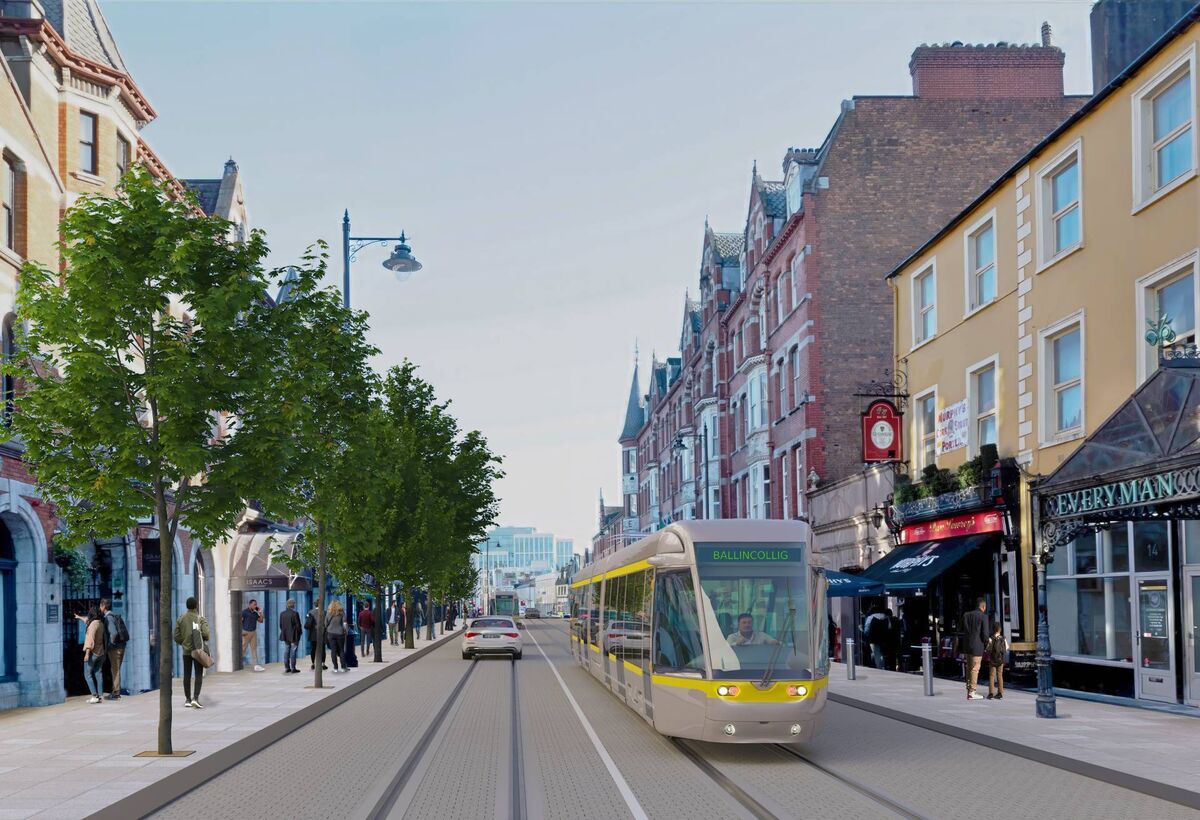
Concern was raised by respondents, including the Victorian Quarter group, about the route’s possible impact on the outdoor dining experience on MacCurtain St, stating that “this is vital to maintaining the vibrant atmosphere on the street”.
A submission from the Metropole Hotel on MacCurtain St highlighted “the need for access to maintain its historic building by using large equipment, like a mobile elevating work platform” and also “requested protective measures for decorative columns and the building façade”.
An alternative route was mentioned in lieu of using MacCurtain St: The Quays. A submission suggested that “this would avoid disrupting a recently upgraded street and offer regeneration opportunities for the quays”, said the report.
Social Democrats TD Pádraig Rice submitted: “Currently, the quays are dominated by car traffic.
Submissions included some from Paladar Bar, MacCurtain Wine Cellar, The Glass Curtain, and Hotel Isaacs, which mentioned the economic impact of the project on their businesses.
Potential damage to building basements, restricted pedestrian access, and reduced access for guests and suppliers were all raised by the businesses.
A submission from MacCurtain Wine Cellar said: “We have concerns... about underground services and existing cellars... As a business that cannot function without its basement, it is worrying.”
Suggestions put forward by some respondents include closing both MacCurtain St and St Patrick’s Street to general car traffic, as well as avoiding the placement of bus stops within tram lanes.
Cork Chamber’s submission stated: “It is important that the light-rail system runs as efficiently as possible. Therefore, any opportunity to minimise mixed-traffic interactions must be explored… The location of bus stops within tram lanes should be avoided, where feasible, to ensure the success of both the light-rail project and BusConnects.”
Concerns were also raised about the potential for antisocial behaviour on MacCurtain St and a possible effect on theatre venues, “due to construction and tram activity”.
Some 61 submissions referenced the inclusion of MacCurtain St and St Patrick’s Street on the emerging preferred route for the Luas line.
According to the report, “there were also questions about too many turns and curves in the proposed city centre alignment, with suggestions that this could reduce efficiency and increase journey times”.
Improving efficiency was behind suggestions made by some respondents about consolidating the three proposed stops on St Patrick’s St in to one central stop.
The report also noted: “Respondents expressed support for the integration of high-quality public realm improvements along the proposed route, with calls to enhance rather than compromise key areas such as Grand Parade, St Patrick’s Street and MacCurtain Street.
"The legacy of the Cork Electric Tramways and Lighting Company was referenced, with an emphasis on the importance of thoughtful integration into the city’s visual landscape.
"Suggestions included the use of high-quality materials, well-designed landscaping and coordinated street furniture and lighting to ensure the tram route complements its surroundings.



